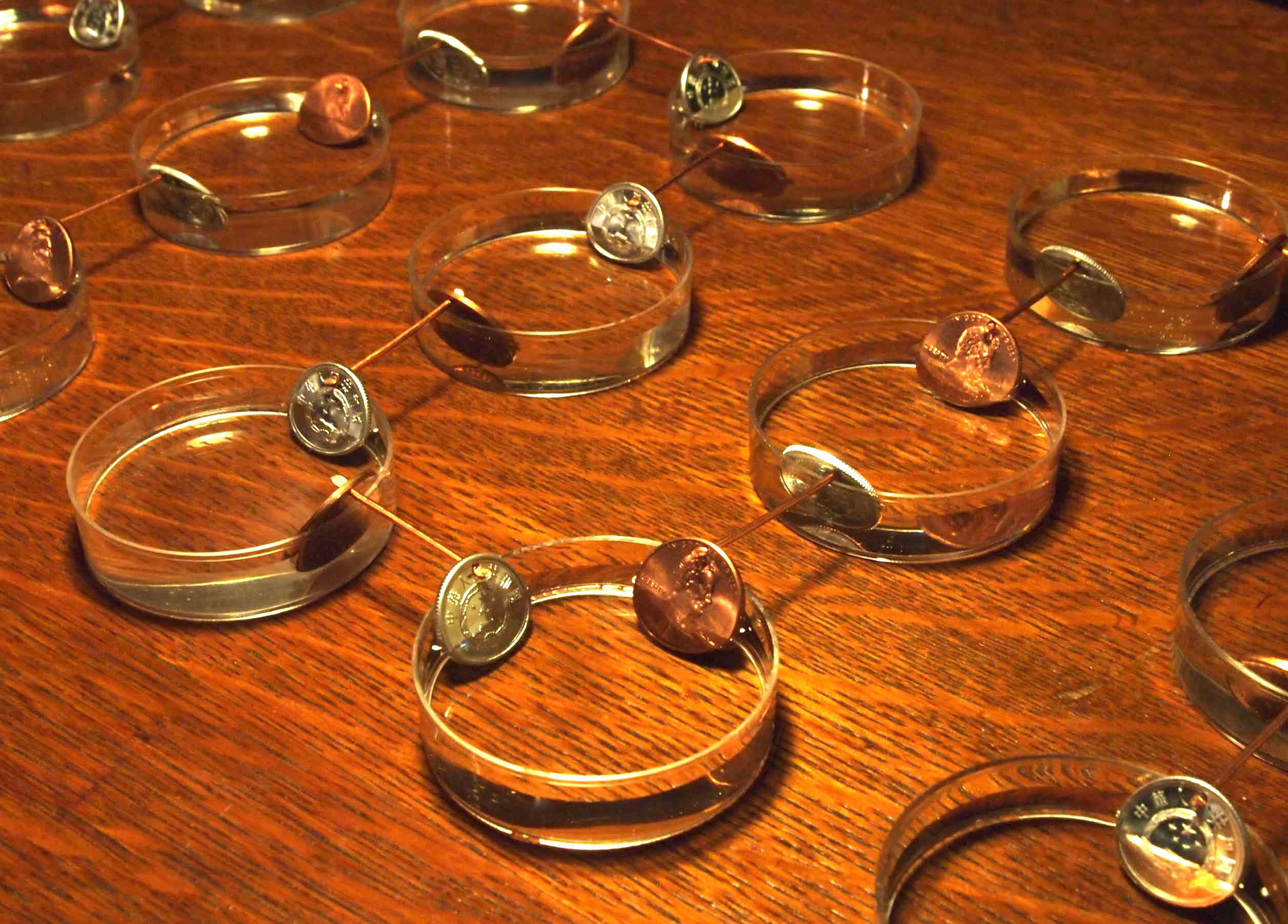Making Money Work: Using Coins to Generate Electricity

A conceptual artist's latest thought experiment takes aim at both the financial and energy crises by harnessing money's instability and using it to generate electricity.
While currency traders exploit fluctuations in world currencies for their own financial gain, Jonathon Keats is taking advantage of the actual physical instability of metal coins. Keats has built an electrical circuit that is completely powered by the process of ion swapping between American and Chinese coins. [Photo]
"Money is inherently unstable," Keats said. "[We're] looking at currency fluctuation as more than a mere abstraction. We're actually putting money to work." Some of Keats' previous projects include copyrighting his own mind, trying to pass the mathematical Law of Identity, A = A, as statutory law in Berkeley, Calif., and collaborating with geneticists in an attempt to genetically engineer God. Among many other projects, he also opened the world's first porn theater for plants, projecting video footage of pollination onto the foliage of rhododendrons.
Keats' tabletop system of international currency exchange is located in the basement of a New York skyscraper, and consists of American pennies and Chinese fen (coins worth about one-tenth of a U.S. cent) dipped in petri dishes full of seawater, and wired together with a "computing hub" — i.e. calculators.
Fen are made of aluminum, whereas pennies are clad in copper. The two metals undergo "galvanic corrosion" when submerged together in an electrolyte, an ion-rich substance such as seawater. In this process, one metal (in this case, the aluminum) corrodes more quickly than the other (the copper), causing positively charged ions to flow from the former to the latter through the water, and a current of electrons to flow in the opposite direction through wires attached to the coins.
"You can think of it as electro-chemical arbitrage," Keats joked. "And it works equally well in bull and bear markets. With our current setup, using several dozen cells filled with saltwater from the Pacific Ocean, we've generated as much as 18.7 volts" — about enough to power three calculators. [What Would Happen If We Returned to the Gold Standard?]
The more pairs of submerged coins you wire together in series, the more energy you can generate. "The U.S. Mint strikes between 4 billion and 5 billion cents per year. The number of fen struck in China is not made public by the Chinese government, but Japanese yen and Thai satang are also aluminum, as is the Peruvian 5 centimos coin. So with a bit of land — most likely not in midtown Manhattan — and some good ocean access, you could probably operate the latest IBM Blue Gene [supercomputer]. Or you could certainly power a lot of iPhones," Keats toldLife's Little Mysteries.
Get the world’s most fascinating discoveries delivered straight to your inbox.
He estimated that operating the IBM Blue Gene, which draws 6 megawatts of power, would require about 600 million pairs of coins — "pocket change by the standards of how many pennies the U.S. government mints annually."
And unlike the high-stakes, high entry-bar foreign exchange market, Keats said his form of currency exchange is inexpensive, reliable and requires minimal expertise. "This is money at its most democratic," he said. "Unlike credit-default swaps, electro-chemical arbitrage is for the 99 percent — and the value is real, measurable in volts and amps."
Follow Natalie Wolchover on Twitter @nattyover. Follow Life's Little Mysteries on Twitter @llmysteries, then join us on Facebook.
Natalie Wolchover was a staff writer for Live Science from 2010 to 2012 and is currently a senior physics writer and editor for Quanta Magazine. She holds a bachelor's degree in physics from Tufts University and has studied physics at the University of California, Berkeley. Along with the staff of Quanta, Wolchover won the 2022 Pulitzer Prize for explanatory writing for her work on the building of the James Webb Space Telescope. Her work has also appeared in the The Best American Science and Nature Writing and The Best Writing on Mathematics, Nature, The New Yorker and Popular Science. She was the 2016 winner of the Evert Clark/Seth Payne Award, an annual prize for young science journalists, as well as the winner of the 2017 Science Communication Award for the American Institute of Physics.



